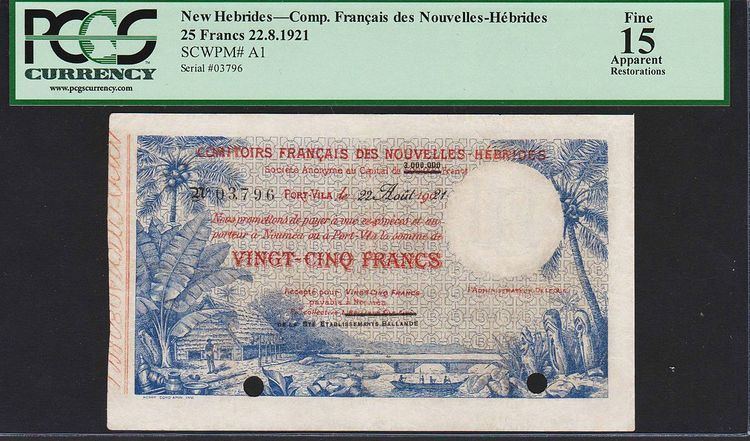Banknotes 100, 500, 1000 francs | Symbol Fr | |
 | ||
Coins 1, 2, 5, 10, 20, 50, 100 francs Central bank Institut d'émission d'Outre-Mer (IEOM) | ||
The Franc was the currency of the Anglo-French Condominium of the Pacific island group of the New Hebrides (which became Vanuatu in 1980). It circulated alongside British and later Australian currency. The New Hebrides franc was nominally divided into 100 Centimes, although the smallest denomination was the 1 franc. Between 1945 and 1969, it was part of the CFP franc.
Contents
History
Until World War II, the New Hebrides used the French franc and the British and Australian pounds. In 1941, the Free French forces introduced paper money for circulation on the New Hebrides. In 1945, the CFP franc was introduced to insulate France's Pacific colonies from the devaluation of the French franc and the New Hebrides used a combination of New Caledonian franc coins and locally issued notes.
In 1949, the CFP franc's relationship to the French franc stabilized at 5.5 French francs = 1 CFP franc. From 1959, the exchange rate to the Australian pound was almost exactly 200 francs = 1 pound. This rate became 100 francs = 1 Australian dollar in 1966 when the dollar was introduced. The Australian dollar circulated alongside the local currency.
From 1966, coins were produced in the name of the New Hebrides. In 1969, the New Hebrides franc broke away from the CFP franc and maintained the relationship with the Australian dollar of 100 francs = 1 dollar until 1973. In 1982, the franc was replaced at par by the vatu following independence as Vanuatu. At the same time, the Australian dollar ceased to officially circulate.
Coins
In 1966, silver 100 franc coins were introduced. These were followed by nickel 10 and 20 francs in 1967, nickel-brass 1, 2 and 5 francs in 1970 and nickel 50 francs in 1972. Only the nickel coins (10, 20, and 50 francs) were the same size, composition, and obverse as the corresponding French Polynesian and New Caledonian coins.
The overall design has not changed since the introduction of the New Hebrides franc coins. The only notable change is the addition of "I.E.O.M" (Institut d'émission d'Outre-Mer) in 1973.
